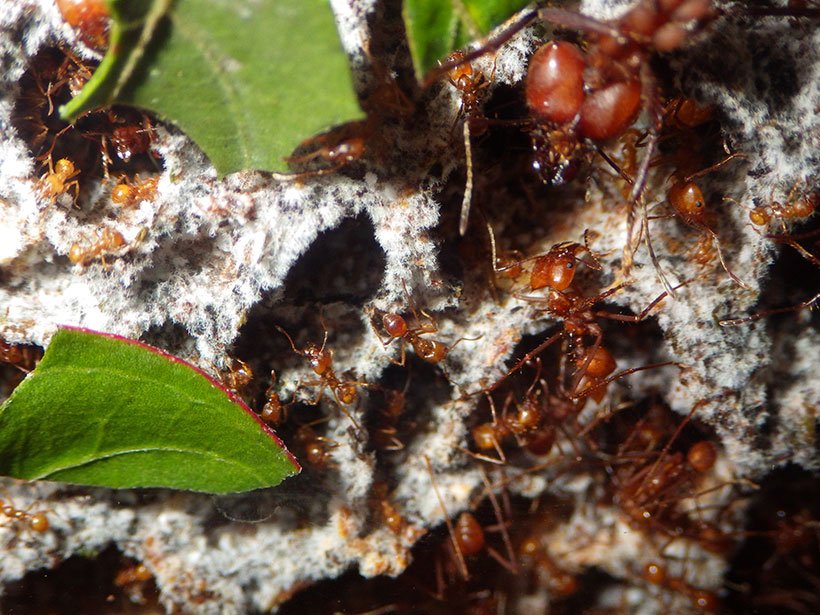On the forest floor, leaf-cutter ant nests look like massive piles of dirt dotted with several holes. A new study finds that these holes release carbon dioxide from the ant nests into the air—up to 100,000 times more carbon dioxide than from surrounding soil surfaces. Researchers estimate this contribution to be nearly 0.5% of total forest carbon dioxide emissions. This study was presented on 10 December at AGU’s Fall Meeting 2018, held in Washington, D. C., and it was also recently published in the Journal of Geophysical Research: Biogeosciences.
These social creatures build underground nests that can go deeper than 6 meters and stretch as wide as a tennis court.
In tropical forests in the Western Hemisphere, leaf-cutter ants are everywhere. These social creatures build underground nests that can go deeper than 6 meters and stretch as wide as a tennis court. The nests are marked by numerous entrances or vents opening to the forest floor, connected to an intricate network of tunnels and chambers within. In some of these chambers, ants feed fresh leaves to fungi, which convert the plant material to a form that’s easier for ants to digest. Other chambers serve as refuse sites for ant carcasses, decomposing fungi, or unused leaves.
“These nests are hot spots for carbon dioxide,” says Angel Fernandez-Bou, a Ph.D. student at the University of California, Merced, and an author of the study. The ant and fungal activities are what generate this carbon dioxide. His team was interested in estimating these nest-generated carbon dioxide levels and understanding whether nest soils released more carbon dioxide into the forest than the surrounding soils did.
The researchers monitored nine leaf-cutter ant nest sites for 30 months at La Selva Biological Station in Costa Rica. They buried probes to sample soil gas at depths 20, 60, and 100 centimeters inside nests and in nonnest soils to compare carbon dioxide levels. They also set up collection chambers above nest vents to measure carbon dioxide outflows from the nest to the air and compared these with surrounding soil emissions.

Vents Make a Difference
The team recorded higher carbon dioxide levels in soils without ant nests, irrespective of depth. These high carbon dioxide levels were more evident in heavy rainfall months when the forest’s clayey soils get saturated with water and don’t allow gases to escape. However, nest soils often maintained lower carbon dioxide levels. “The network of chambers and tunnels allows the soil surrounding the nests to be better aerated,” says Fernandez-Bou.
But he wondered whether the carbon dioxide levels in nest soils were low because there wasn’t a lot of organic matter available for decomposition and carbon dioxide production to begin with. To assess this, his team measured amounts of fine litter, roots, and other organic ingredients in both the nest and nonnest soils. They found more organic content in the nest soils, and they were now certain that it wasn’t a lack of material that led to low carbon dioxide levels. “This is even better for proving that the network for ventilation works,” said Fernandez-Bou.
The temperature difference between the warm air inside the nest and the cooler air above the ground surface causes the warmer, less dense air to rise out of the nest.
The nest vents were indeed releasing a lot more carbon dioxide to the air: A single nest can emit as much as 100,000 times more carbon dioxide than an equivalent area of the surrounding soil. The team attributes these emissions to temperature differences between the inside of the nest and the outside, and these differences are more pronounced at night. The temperature difference between the warm air inside the nest and the cooler air above the ground surface causes the warmer, less dense air to rise out of the nest. Fernandez-Bou and his colleagues now estimate that these nest emissions contribute 0.2%–0.7% of total forest carbon dioxide emissions.
Fernandez-Bou says that traditional ways of measuring carbon dioxide emissions miss these hot spots of carbon dioxide release. He says that these emissions are particularly important, given that leaf-cutter ant nests cover 1.2% of the forest floor. He suspects that there may be other forest species creating such hot spots too.
“I am not surprised that leaf-cutter ants have a meaningful impact on carbon dioxide across the spatial layout of the forest,” said Fiona Soper, an ecosystems ecologist at Cornell University who was not involved in this research. “These ants move hundreds of kilos of plant matter and create soil disturbance. So we should obviously be asking what they are doing to carbon cycling.”
Soper added that further avenues of research could explore patterns of nest emissions for other greenhouse gases like methane and nitrous oxide.
Fernandez-Bou agrees. He thinks that these measurements may be especially important in the current scenario in which global warming is favoring the expansion of leaf-cutter ant ranges.
—Priyanka Runwal ([email protected]; @priyanka_runwal), Science Communication Program Graduate Student, University of California, Santa Cruz
Citation:
Runwal, P. (2019), Ant nests act as carbon dioxide chimneys, Eos, 100, https://doi.org/10.1029/2019EO113081. Published on 07 January 2019.
Text © 2019. The authors. CC BY-NC-ND 3.0
Except where otherwise noted, images are subject to copyright. Any reuse without express permission from the copyright owner is prohibited.

